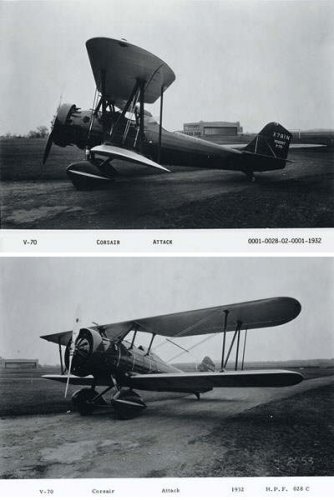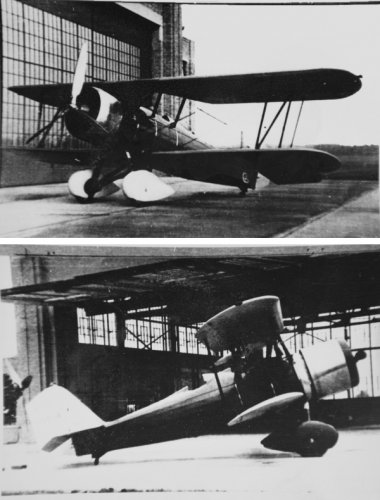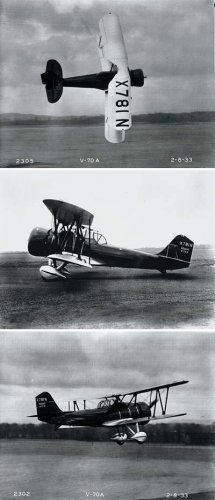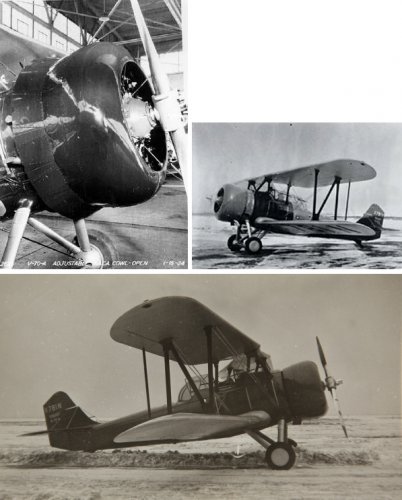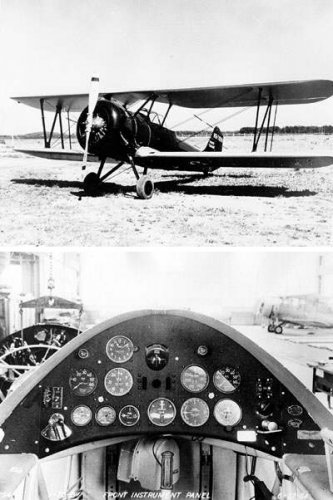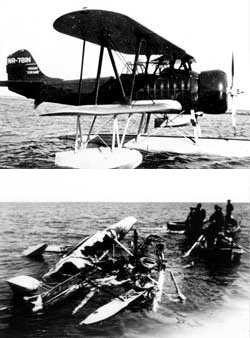- Joined
- 25 June 2009
- Messages
- 14,753
- Reaction score
- 6,147
Several Vought demonstrators had quite an interesting career, and the V-70 was certainly one of them.
Built for an early 1932 U.S. Army Air Corps attack competition, the V-70 prototype (c/n 892) was registered as the strictly experimental X781N. It was quite similar to other members of the Corsair biplane family, a tandem-seat biplane powered by a Pratt & Whitney Wasp engine (image set #1). As a matter of fact, it has been described as an O3U-2 derivative, and the two aircraft are so similar that it might explain why the July 1934 issue of Flying would list the Vought V-70 as a U.S. Navy multiplace fighter... indeed the quite similar SU-1, O3U-2 and O3U-4 may well have been designated "V-70" too, but it's hard to tell because the company designations for most military variants of the Corsair seem to have been lost.
X781N was presumably tested at Wright Field (though I need to find confirmation of this) but was not accepted. Vought took the aircraft back and used it for a while as an engineering test-bed (image set #2).Then in November 1932, Vought set out to modify the prototype into an observation aircraft demonstrator and redesignated it as the V-70A.
In its modified form, the prototype flew in February 1933. It was now powered by a Pratt & Whitney Hornet engine and featured a long canopy, rounded off at the rear by a turret (in the manner of the later Curtiss Owl), making it the very first Vought aircraft with an enclosed cockpit (image set #3). The prototype was again submitted to the U.S.A.A.C., this time for an observation competition (likely against the Curtiss O-40 and Thomas-Morse O-41 and O-42), and probably received the provisional test designation XO-926 at Wright Field during these tests.
After being rejected again by the Air Corps, X781N was used for further testing. The engine cowling was replaced with N.A.C.A.'s controllable flap cowl in January 1934. Tests were made at a constant density altitude above sea-level and at a constant power, less than that at which the engine was rated, to eliminate the effect of density upon the dissipation of heat and the drag of the airplane. In this configuration, the wheel spats were also removed, possibly to counter the slight weight increase brought by the new cowl (image set #4).
X781N was then further modified as the V-70B by fitting a new landing gear with low-pressure wheels and removing the turret (image set #5), and became a company executive aircraft, receiving a modified registration in the "Restricted" class as NR781N. Although company records seem to stop there, there is evidence that the prototype was then shipped to Spain and test-flown by the Spanish Air Force in Madrid. It was then flown to the San Javier Naval Base and reconfigured as a seaplane. The Navy pilots at the base made several flight tests with it, and on 30 April 1935 Navy Lieutenant La Cierva (with Chief Naval Aeronautical Engineer Nardiz as observer) flew it in a high-altitude performance test. However, shortly after reaching the designated altitude, the V-70 caught fire and crashed about 300 meters from the beach, resulting in the death of both occupants. No cause for the accident was determined, but a carburation failure at high altitude was suspected (image set #6).
After being an attack plane, a test-bed, an observation demonstrator, an company executive aircraft and whatever the Spanish Air Force and Navy planned for it, thus ended the life of one of Vought's most beautiful, though unfortunate, biplanes.
Built for an early 1932 U.S. Army Air Corps attack competition, the V-70 prototype (c/n 892) was registered as the strictly experimental X781N. It was quite similar to other members of the Corsair biplane family, a tandem-seat biplane powered by a Pratt & Whitney Wasp engine (image set #1). As a matter of fact, it has been described as an O3U-2 derivative, and the two aircraft are so similar that it might explain why the July 1934 issue of Flying would list the Vought V-70 as a U.S. Navy multiplace fighter... indeed the quite similar SU-1, O3U-2 and O3U-4 may well have been designated "V-70" too, but it's hard to tell because the company designations for most military variants of the Corsair seem to have been lost.
X781N was presumably tested at Wright Field (though I need to find confirmation of this) but was not accepted. Vought took the aircraft back and used it for a while as an engineering test-bed (image set #2).Then in November 1932, Vought set out to modify the prototype into an observation aircraft demonstrator and redesignated it as the V-70A.
In its modified form, the prototype flew in February 1933. It was now powered by a Pratt & Whitney Hornet engine and featured a long canopy, rounded off at the rear by a turret (in the manner of the later Curtiss Owl), making it the very first Vought aircraft with an enclosed cockpit (image set #3). The prototype was again submitted to the U.S.A.A.C., this time for an observation competition (likely against the Curtiss O-40 and Thomas-Morse O-41 and O-42), and probably received the provisional test designation XO-926 at Wright Field during these tests.
After being rejected again by the Air Corps, X781N was used for further testing. The engine cowling was replaced with N.A.C.A.'s controllable flap cowl in January 1934. Tests were made at a constant density altitude above sea-level and at a constant power, less than that at which the engine was rated, to eliminate the effect of density upon the dissipation of heat and the drag of the airplane. In this configuration, the wheel spats were also removed, possibly to counter the slight weight increase brought by the new cowl (image set #4).
X781N was then further modified as the V-70B by fitting a new landing gear with low-pressure wheels and removing the turret (image set #5), and became a company executive aircraft, receiving a modified registration in the "Restricted" class as NR781N. Although company records seem to stop there, there is evidence that the prototype was then shipped to Spain and test-flown by the Spanish Air Force in Madrid. It was then flown to the San Javier Naval Base and reconfigured as a seaplane. The Navy pilots at the base made several flight tests with it, and on 30 April 1935 Navy Lieutenant La Cierva (with Chief Naval Aeronautical Engineer Nardiz as observer) flew it in a high-altitude performance test. However, shortly after reaching the designated altitude, the V-70 caught fire and crashed about 300 meters from the beach, resulting in the death of both occupants. No cause for the accident was determined, but a carburation failure at high altitude was suspected (image set #6).
After being an attack plane, a test-bed, an observation demonstrator, an company executive aircraft and whatever the Spanish Air Force and Navy planned for it, thus ended the life of one of Vought's most beautiful, though unfortunate, biplanes.

